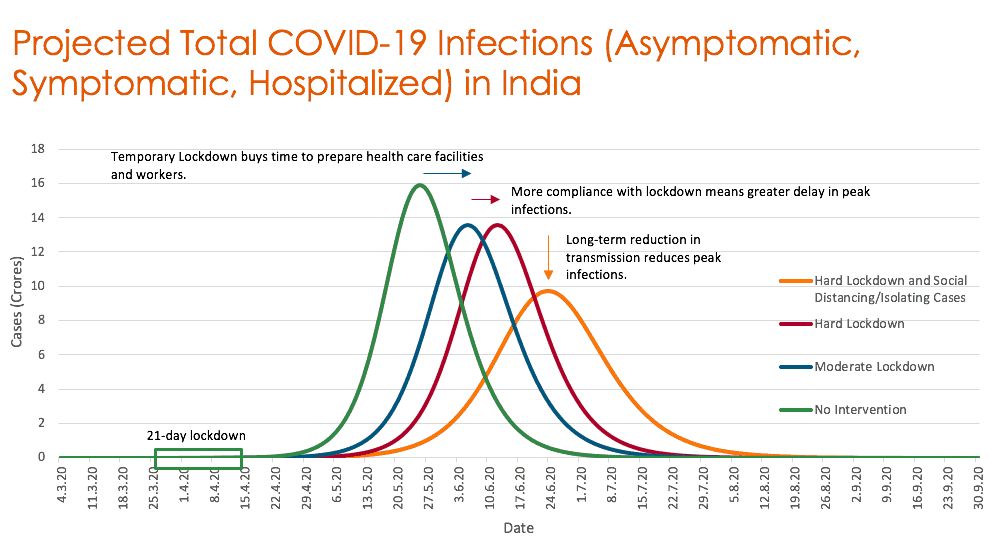April 20, 2020

The Question: COVID-19 is spreading rapidly worldwide, overburdening health systems with new cases. As of April 4th 2020, COVID-19 cases have been identified in 29 Indian states and union territories. As testing continues to expand rapidly, an influx of additional cases can be expected in the near future. To contain the spread of the novel virus and to keep infections at a manageable level, many countries have instituted lockdowns and social distancing. India has implemented a nationwide 21-day lockdown, which is predicted to avert a large number of COVID-19 infections in the short term, although it is unknown how the outbreak will unfold once the lockdown is lifted.
What We Found: In this report, researchers at CDDEP, Johns Hopkins, and Princeton modeled the impact of the 21-day lockdown on the spread of COVID-19 in India; before, during, and after the lockdown is lifted. The analysis includes four scenarios:
- Baseline – Disease continues to spread with no lockdown, social distancing, or other intervention and no change in transmission rate. R0 = 2.66.
- Moderate Lockdown – Reduce transmission to R0 of 2 during lockdown period, then transmission resumes at R0 of 2.4.
- Hard Lockdown – Reduce transmission to R0 of 1.5 during lockdown period, then transmission resumes at R0 of 2.4.
- Hard Lockdown and Continued Social Distancing/Isolating Cases– Reduce transmission to R0 of 1.5 during lockdown period, then, through social distancing regulations and isolation of symptomatic individuals, resumes at R0 of 2.
Study assumptions are contained in the slides.
The study found that India’s current lockdown will significantly slow the spread of COVID-19 hospitalizations and moderate infections compared to a lack of interventions. The temporary lockdown will buy time for health systems to prepare for the peak of the outbreak by building temporary healthcare facilities and obtaining additional personnel, hospital beds, and equipment. It is vital to build up healthcare infrastructure quickly to prepare for an increase in hospitalized cases. In addition to providing shelter and care for the sick, such an investment may provide a livelihood for workers and reduce the negative impacts of restrictions. The long-term interventions including a 25 percent and 50 percent quarantine of symptomatic cases would further delay and reduce the peak of COVID-19 infections and hospitalizations in India. While the potential impact of an individual policy is unknown, it is clear that a longer-term policy of reducing social contacts can have a large effect.
Why It Matters: The results of this analysis suggest that immediate physical distancing will reduce the burden of COVID-19 on the healthcare system and reduce the risk of mortality among high-risk patients. A temporary lockdown allows time to build the capacity of hospitals and health care workers. Long-term impacts can be achieved through a combination of policies that reduce the transmission of the virus including immediate isolation of all individuals demonstrating symptoms of influenza-like illness, physical distancing and universal masking, restrictions on large gatherings and events, improved sanitation and hygiene, and increased testing availability.
The study titled “COVID-19 India: Potential Impact of the Lockdown and Other Longer-Term Policies” by Emily Schueller, Eili Klein, Gary Lin, Katie Tseng, Geetanjali Kapoor, Aditi Sriram, Arindam Nandi, and Ramanan Laxminarayan is online here.
Please note:
- These are non-peer-reviewed results of the analysis of a fast-moving epidemic with many uncertain parameters. Researchers worldwide are producing this type of rapid results in the form of similar unpublished studies and reports. Our findings may change in the future as new insights on the SARS-CoV-2 virus and COVID-19 emerge.
- This research was produced by a team of researchers at CDDEP, John Hopkins University, and Princeton University. As is the standard research practice, this work does not represent the views of these institutions.
- For comments and clarifications, please email Emily Schueller ([email protected]).











